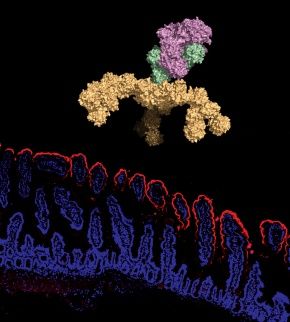Possible botulism blocker
Study reveals structure of ‘gateway’ compound in lethal food-borne toxin
U.S. and German scientists have decoded a key molecular gateway for the toxin that causes botulism, pointing the way to treatments that can keep the food-borne poison out of the bloodstream.

Illustration courtesy of Rongsheng Jin
Study leaders Rongsheng Jin, associate professor of physiology & biophysics at UC Irvine, and Andreas Rummel of the Institute for Toxicology at Germany’s Hannover Medical School created a three-dimensional crystal model of a complex protein compound in the botulinum neurotoxin. This compound binds to the inner lining of the small intestine and allows passage of the toxin into the bloodstream.
The 3-D structure – shaped much like the Apollo lunar landing module – let the researchers identify places on the surface of the complex protein that enable it to dock with carbohydrates located on the small intestine’s interior wall. In tests on mice, they found that certain inhibitor molecules blocked the botulism compound from connecting to these sites, which prevented the toxin from entering the bloodstream.
Botulinum neurotoxins are produced by Clostridium botulinum and cause the possibly fatal disease botulism, which impedes nerve cells’ ability to communicate with muscles and can lead to paralysis and respiratory failure. The botulinum toxin has also been identified as a potential biological weapon against a civilian population.
“Currently, there is no efficient countermeasure for this toxin in case of a large outbreak of botulism,” Jin said. “Our discovery provides a vital first step toward a pharmaceutical intervention at an early point that can limit the toxin’s fatal attack on the human body.”
Study results appear online in the journal PLOS Pathogens.
Jin added that his work opens the door to further development of preventive treatments for botulism. At the same time, the molecular gateway for the lethal toxin could be exploited for alternative applications, such as the oral delivery of protein-based therapeutics.
Most read news
Organizations
Other news from the department science

Get the life science industry in your inbox
By submitting this form you agree that LUMITOS AG will send you the newsletter(s) selected above by email. Your data will not be passed on to third parties. Your data will be stored and processed in accordance with our data protection regulations. LUMITOS may contact you by email for the purpose of advertising or market and opinion surveys. You can revoke your consent at any time without giving reasons to LUMITOS AG, Ernst-Augustin-Str. 2, 12489 Berlin, Germany or by e-mail at revoke@lumitos.com with effect for the future. In addition, each email contains a link to unsubscribe from the corresponding newsletter.





















































